Europe Prefabricated Housing Market Size
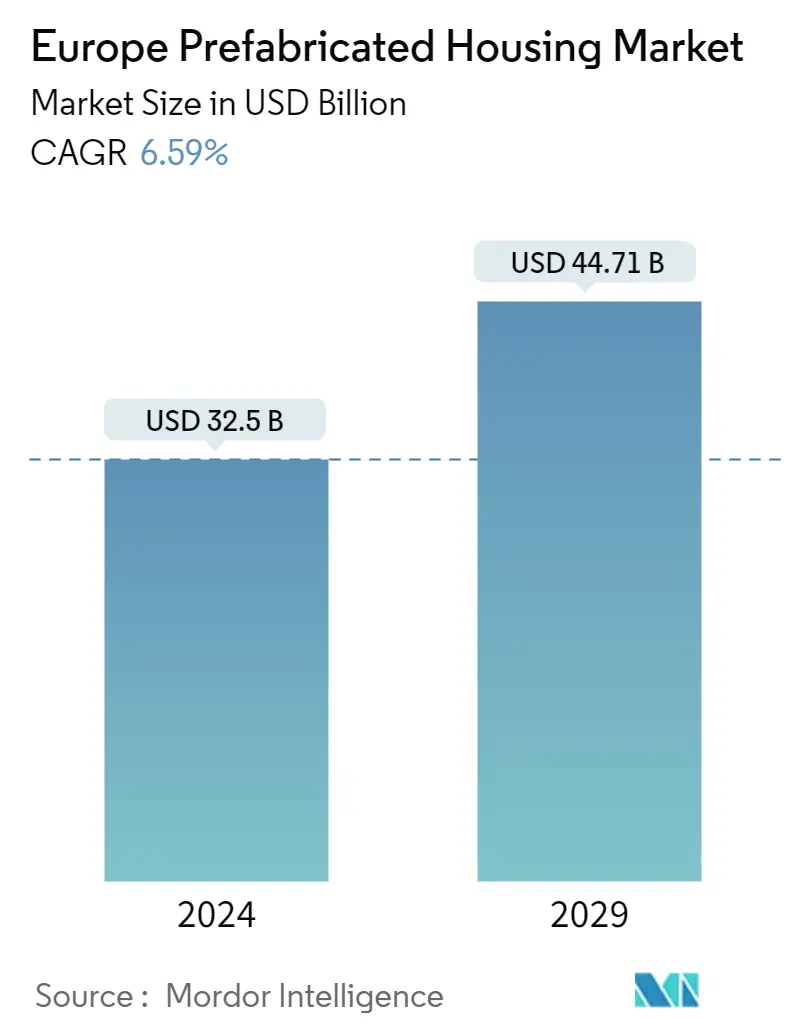
| Study Period | 2020 - 2029 |
| Base Year For Estimation | 2023 |
| Market Size (2024) | USD 32.5 Billion |
| Market Size (2029) | USD 44.71 Billion |
| CAGR (2024 - 2029) | 6.59 % |
| Market Concentration | Low |
Major Players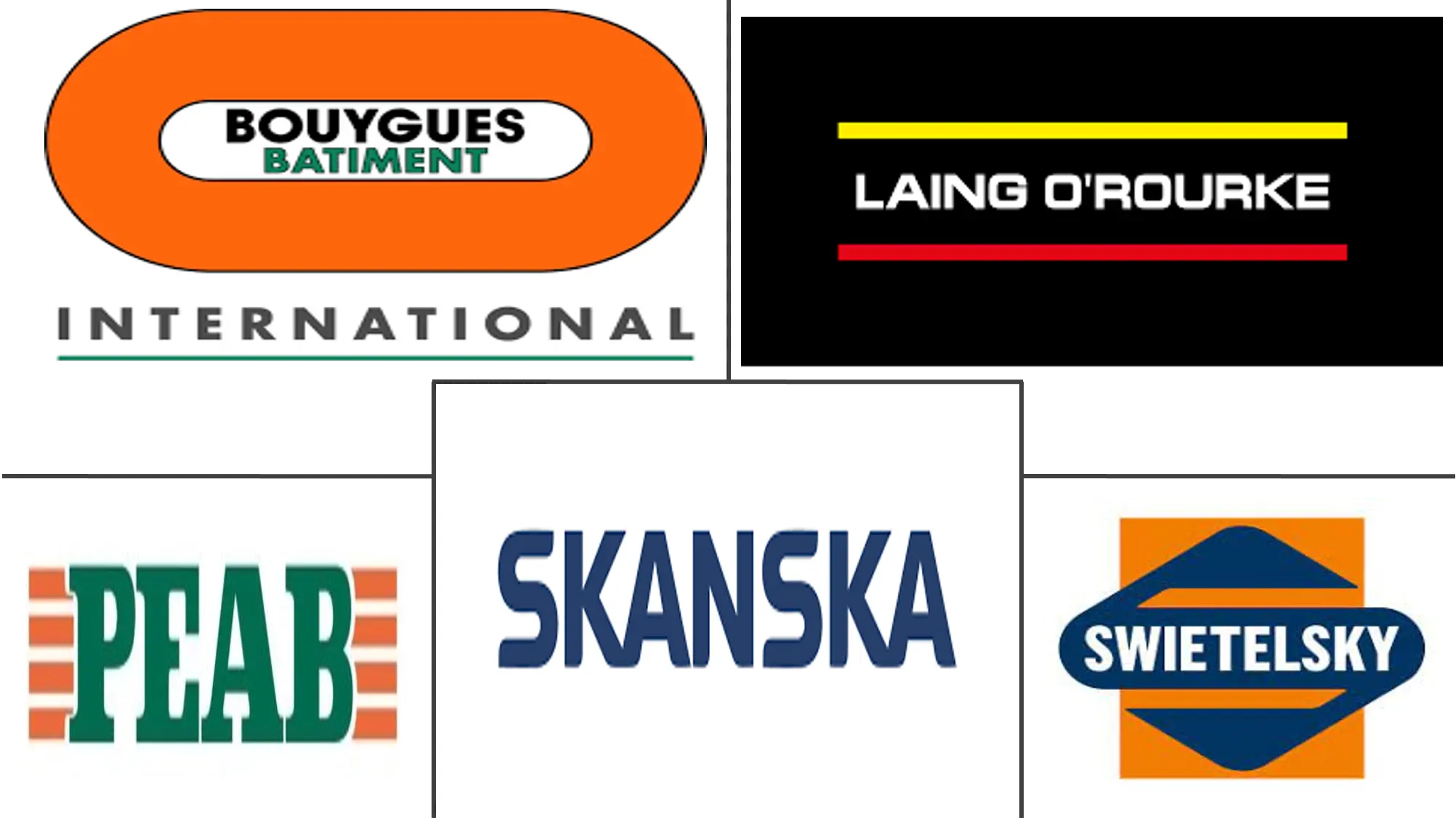
*Disclaimer: Major Players sorted in no particular order |
Europe Prefabricated Housing Market Analysis
The Europe Prefabricated Housing Market size is estimated at USD 32.5 billion in 2024, and is expected to reach USD 44.71 billion by 2029, growing at a CAGR of 6.59% during the forecast period (2024-2029).
The European prefabricated housing market is mainly driven by low- to mid-rise residential buildings, project homes, and public housing demand. The value of the modular construction sector in Poland has increased by almost half over the past two years as prefabricated technology is increasingly used to construct buildings. A large selection of available materials and a rise in raw material prices and labor costs have helped the process.
The construction of the two modules that make up a two-bedroom home takes only 14 days in L&G's factory. Dispatched on the back of lorries and bolted together on site, a house has staircases, windows, doorways, a fully equipped kitchen and bathroom, sockets, radiators, and a heat pump. Modular homes are in the top energy performance bracket, so they could save an average household up to GBP 800 (USD 1013.49) a year on energy bills, according to the industry group Make UK Modular. L&G aims to produce 450 homes at the factory this year but could increase this to 3,000 annually.
Another modular firm, the Goldman Sachs-backed Top Hat company, is creating its second housing site near Corby. It will be the largest 3D modular housing factory in western Europe, the size of 11 football fields. It is planning to build 4,000 homes a year.
According to Make UK Modular, by 2025, the industry will have been able to produce 20,000 prefab homes. The government has set a target of 300,000 new homes annually by 2025, representing a fifth of the 100,000 annual shortfall.
The prefabricated housing market is growing across Europe as people increasingly focus on turnkey solutions that tick all the modern boxes. The manufacturing firms' acceptance and ease of planning and consent processes are expected to boost demand further. Modular construction is gaining popularity across the European region owing to population growth and shortages in housing. It is gaining momentum as an effective means to build affordable housing.
In Italy, the demand for prefabricated, anti-seismic houses in steel is expected to gain popularity, owing to their validity and efficiency in housing safety. It is applicable, especially in those areas subjected to recurrent seismic events. Sweden is one of the world's most developed markets for prefabricated construction, with a high penetration rate.
Sweden is the leading country in implementing penalized building systems, where around 80% of its housing sector uses structures and elements prefabricated in factories. Offsite manufacturing is used in Sweden to build at least 45% of its new homes and 30% of new-build multi-residence buildings. According to an industrial study, about eight out of 10 detached houses in Sweden are built using modern methods.
Europe Prefabricated Housing Market Trends
Huge Demand for Multi-family Houses Driving Market Growth
- Germany is Europe's largest multi-family market, which is worth approximately EUR 8 billion in investment. Denmark and France ranked second and third with about EUR 5 billion and EUR 3.5 billion, respectively.
- The United Kingdom is experiencing significant demand for housing, particularly in urban areas. Such demand is likely to continue or even increase in the long run. Converting office spaces into multi-family properties provides an opportunity to capitalize on this demand.
- Construction completions of 140,900 units in Q4 2023 brought the annual total to 416,500—the highest amount since 1996. Reduced construction starts in recent quarters are expected to lower deliveries in 2025 and beyond. Q4 2023 multi-family investment volume of USD 25.7 billion brought the annual total to USD 117.5 billion, down by 60% from 2022. However, the sector retained the most significant investment volume of commercial real estate at 32%.
- In September 2023, asset and investment manager MPC Capital expanded its leading role in the market for ESG real estate investments. The property comprises two multi-family houses with around 7,000 sq. m of living space spread over 113 residential units. In addition, the property, completed and fully rented in mid-2022, includes 39 underground parking spaces and one commercial unit. The property is in the Pankow district, within walking distance of the famous Prenzlauer Berg district.
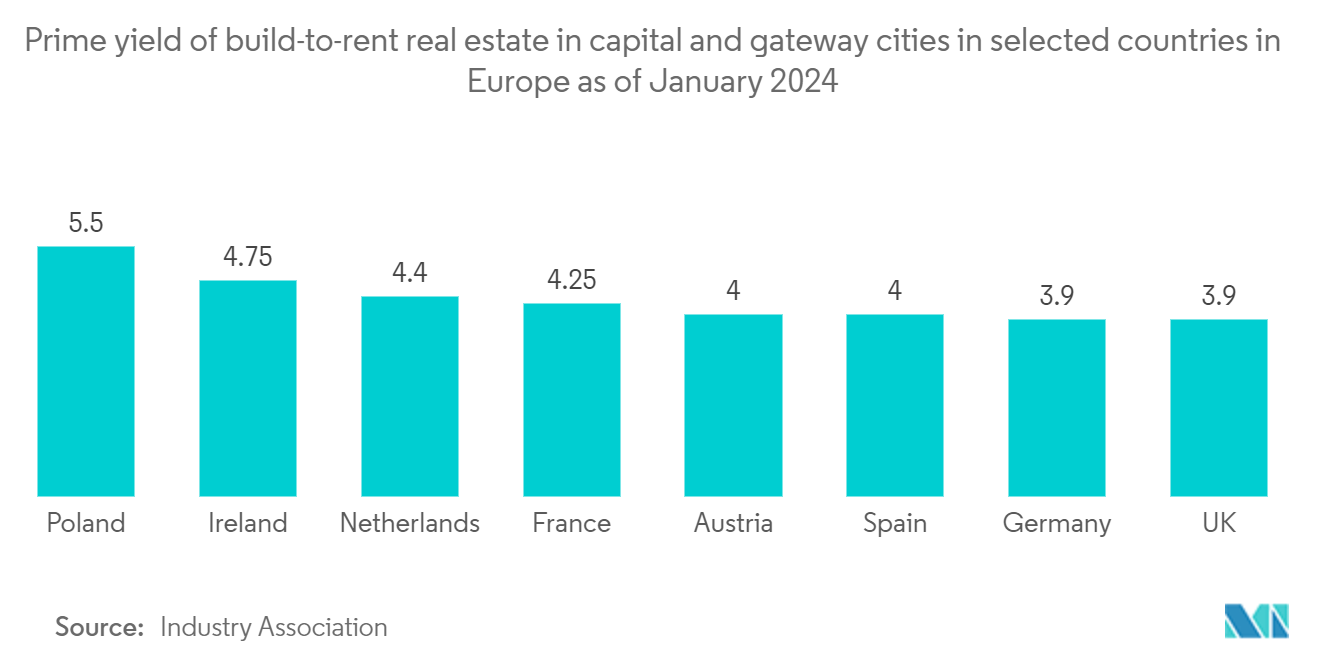
The United Kingdom is Dominating the Market
- While technology has revolutionized many aspects of life, including transportation, entertainment, shopping, and consumer goods, housebuilding has been slow to catch up. That is all set to change with the introduction of the next generation of factory-built modular homes.
- A new report from Make UK Modular, in collaboration with KOPE, has revealed that by 2025, the modular housing industry will be able to provide 20,000 energy-efficient, low-carbon homes across the United Kingdom. These homes will be 55% less likely to need to be heated than the average UK family house and will be built twice as fast.
- Modular manufacturers are already setting up plants in post-industrial small towns or cities, employing more than 3,000 people, and bringing GBP 700 million (USD 860.10 million) of investment to low-growth, low-employment areas.
- The government has expedited the planning process for modular homes and committed to 20% of the affordable housing program for modular homes, which would double new jobs in a short period.
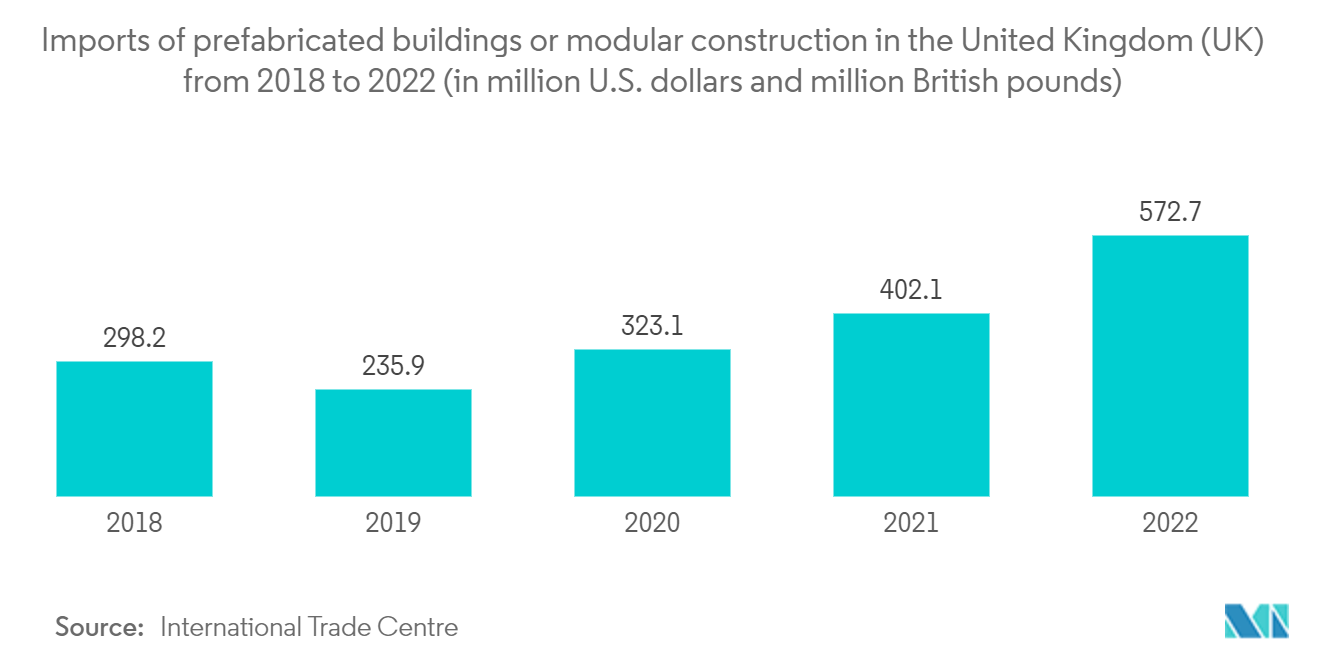
Europe Prefabricated Housing Industry Overview
The European prefabricated housing market is highly fragmented, with no players occupying a significant share. Skanska AB, Peab AB, Swietelsky AG, Laing O'Rourke, and Bouygues Batiment International are major players. The market is expected to grow during the forecast period due to increased prefab construction building investments, upcoming vital projects in the country, and other factors driving the market. Prefabricated building systems and construction hold a high potential to improve the efficiency and performance of the European construction industry in a more sustainable sense. Companies use environment-friendly materials and manufacturing techniques to differentiate their products.
Europe Prefabricated Housing Market Leaders
-
Skanska AB
-
Peab AB
-
Swietelsky AG
-
Laing O'Rourke
-
Bouygues Batiment International
*Disclaimer: Major Players sorted in no particular order
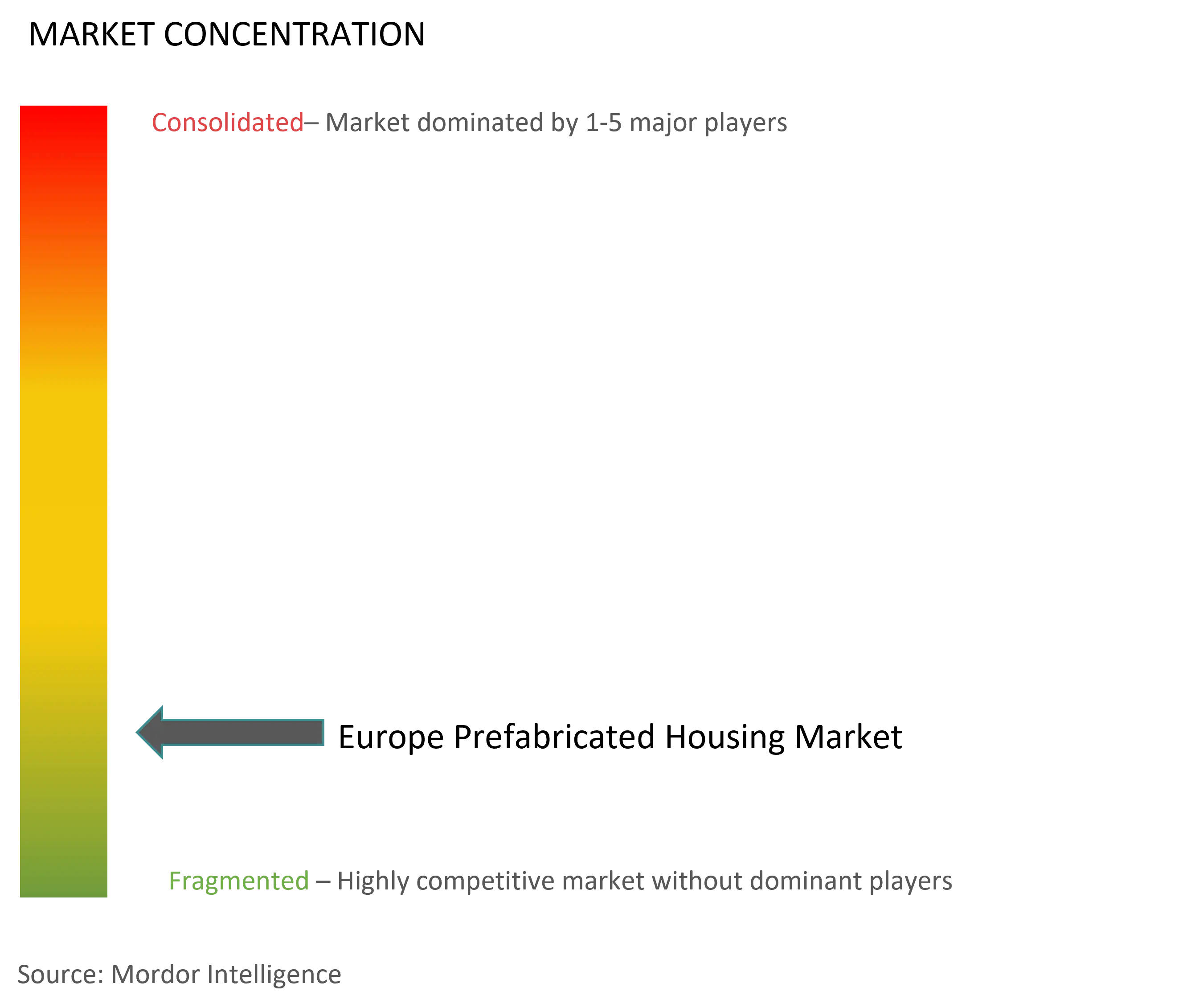
Europe Prefabricated Housing Market News
- March 2023: HAUBNER GROUP and SEMODU AG proposed constructing Europe's most advanced production facility for modular housing to meet the German government's target of constructing 400,000 units annually. HAUBNER GROUP's current production facility in Neumarkt in der Oberpfalz will construct a production facility with a maximum floor area of 40,000 sq. m. A production line for modules focused on the manufacturing procedures used in the automotive industry will be constructed at this location. It aims to establish a technological foundation for the next industrialization stage of home development.
- January 2023: Europe's largest modular housing site began construction, thanks to TopHat, the top 3D modular housebuilder in the United Kingdom. The state-of-the-art 650,000 sq. ft plant can produce a home every hour, creating 1,000 new, highly skilled green jobs in various positions. After being constructed, the facility will be outfitted with a custom, cutting-edge robotic production line and begin shipping its first products in 2024. The new building is expected to follow "BREEAM Excellent" guidelines.
Europe Prefabricated Housing Market Report - Table of Contents
1. INTRODUCTION
- 1.1 Study Assumptions
- 1.2 Scope of the Study
2. RESEARCH METHODOLOGY
- 2.1 Analysis Methodology
- 2.2 Research Phases
3. EXECUTIVE SUMMARY
4. MARKET INSIGHTS
- 4.1 Current Market Scenario
- 4.2 Technological Trends
- 4.3 Insights on Supply Chain/Value Chain Analysis of the Prefabricated Housing Industry
- 4.4 Cost Structure Analysis of the Prefabricated Housing Industry
- 4.5 Impact of COVID-19 on the Market
- 4.6 Insights on Different Types of Materials Used in Prefabricated Housing Construction
5. MARKET DYNAMICS
-
5.1 Drivers
- 5.1.1 Huge Demand for Prefabricated Housing Driving the Market
- 5.1.2 Huge Demand for Multi-family Houses Driving Market Growth
-
5.2 Restraints
- 5.2.1 Lack of Awareness of Prefabricated Market
- 5.2.2 Lack of Standardization and Regulation in the Prefabricated Buildings Industry
-
5.3 Opportunities
- 5.3.1 Growing Demand for Sustainable and Energy-efficient Buildings
- 5.3.2 Increasing Popularity in Modular Construction
-
5.4 Industry Attractiveness - Porter's Five Forces Analysis
- 5.4.1 Bargaining Power of Suppliers
- 5.4.2 Bargaining Power of Consumers / Buyers
- 5.4.3 Threat of New Entrants
- 5.4.4 Threat of Substitute Products
- 5.4.5 Intensity of Competitive Rivalry
6. MARKET SEGMENTATION
-
6.1 By Type
- 6.1.1 Single-family
- 6.1.2 Multi-family
-
6.2 By Country
- 6.2.1 Germany
- 6.2.2 United Kingdom
- 6.2.3 France
- 6.2.4 Rest of Europe
7. COMPETITIVE LANDSCAPE
- 7.1 Overview
-
7.2 Company Profiles
- 7.2.1 Skanska AB
- 7.2.2 Peab AB
- 7.2.3 Swietelsky AG
- 7.2.4 Laing O'Rourke
- 7.2.5 Bouygues Batiment International
- 7.2.6 Derome AB
- 7.2.7 Wolf Holding GmbH
- 7.2.8 DFH Group
- 7.2.9 Containex
- 7.2.10 Portakabin Ltd*
- *List Not Exhaustive
8. FUTURE OF THE MARKET
9. APPENDIX
- 9.1 Marcroeconomic Indicators (GDP Breakdown by Sector, Contribution of Construction to Economy, etc.)
- 9.2 Key Production, Consumption, Exports, and Import Statistics of Construction Materials
Europe Prefabricated Housing Industry Segmentation
Prefabrication is the method of construction where components of a building structure are assembled either in a manufacturing or production site, transporting complete or partial assemblies to the site where the structure should be present. This work is carried out in two stages: manufacturing components in a place other than the final location and their erection in position.
The report covers a complete background analysis of the European prefabricated housing market. It includes the economic assessment and contribution of economic sectors, market overview, market size estimation for key segments, emerging market segments, market dynamics, geographical trends, and the impact of the COVID-19 pandemic.
The European prefabricated housing market is segmented by type (single-family and multi-family) and country (Germany, United Kingdom, France, and Rest of Europe). The report offers the European prefabricated housing market size and forecasts in value (USD) for all the above segments.
| By Type | Single-family |
| Multi-family | |
| By Country | Germany |
| United Kingdom | |
| France | |
| Rest of Europe |
Europe Prefabricated Housing Market Research FAQs
How big is the Europe Prefabricated Housing Market?
The Europe Prefabricated Housing Market size is expected to reach USD 32.5 billion in 2024 and grow at a CAGR of 6.59% to reach USD 44.71 billion by 2029.
What is the current Europe Prefabricated Housing Market size?
In 2024, the Europe Prefabricated Housing Market size is expected to reach USD 32.5 billion.
Who are the key players in Europe Prefabricated Housing Market?
Skanska AB, Peab AB, Swietelsky AG, Laing O'Rourke and Bouygues Batiment International are the major companies operating in the Europe Prefabricated Housing Market.
What years does this Europe Prefabricated Housing Market cover, and what was the market size in 2023?
In 2023, the Europe Prefabricated Housing Market size was estimated at USD 30.36 billion. The report covers the Europe Prefabricated Housing Market historical market size for years: 2020, 2021, 2022 and 2023. The report also forecasts the Europe Prefabricated Housing Market size for years: 2024, 2025, 2026, 2027, 2028 and 2029.
Netherlands Dental Care Industry Report
Statistics for the 2024 Netherlands Dental Care market share, size and revenue growth rate, created by Mordor Intelligence™ Industry Reports. Netherlands Dental Care analysis includes a market forecast outlook 2029 and historical overview. Get a sample of this industry analysis as a free report PDF download.



